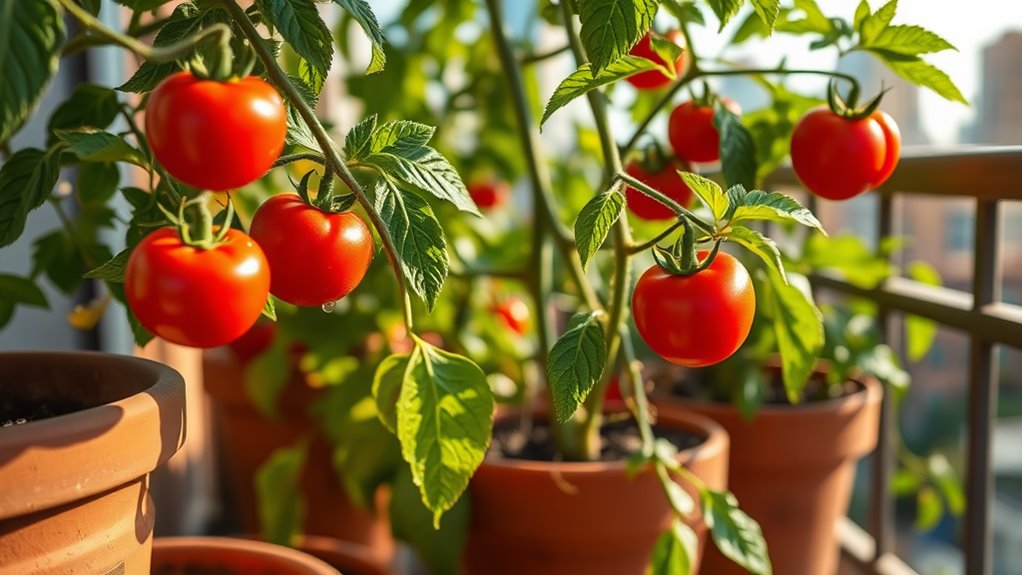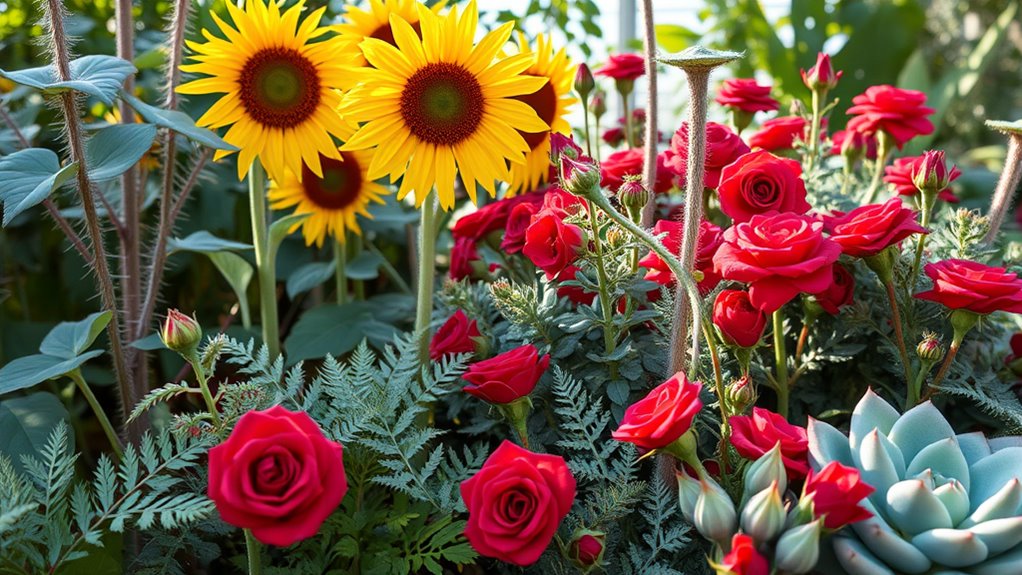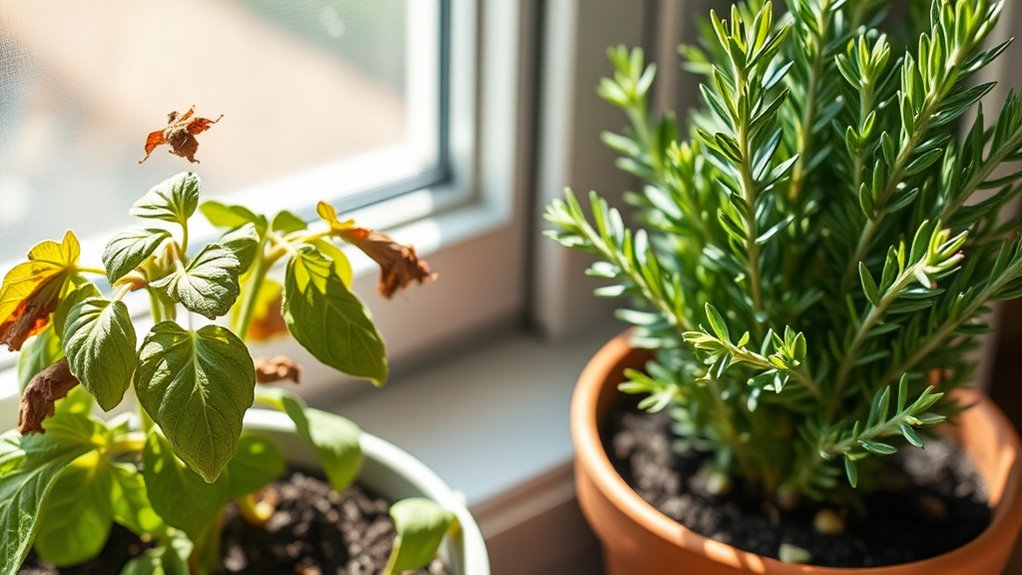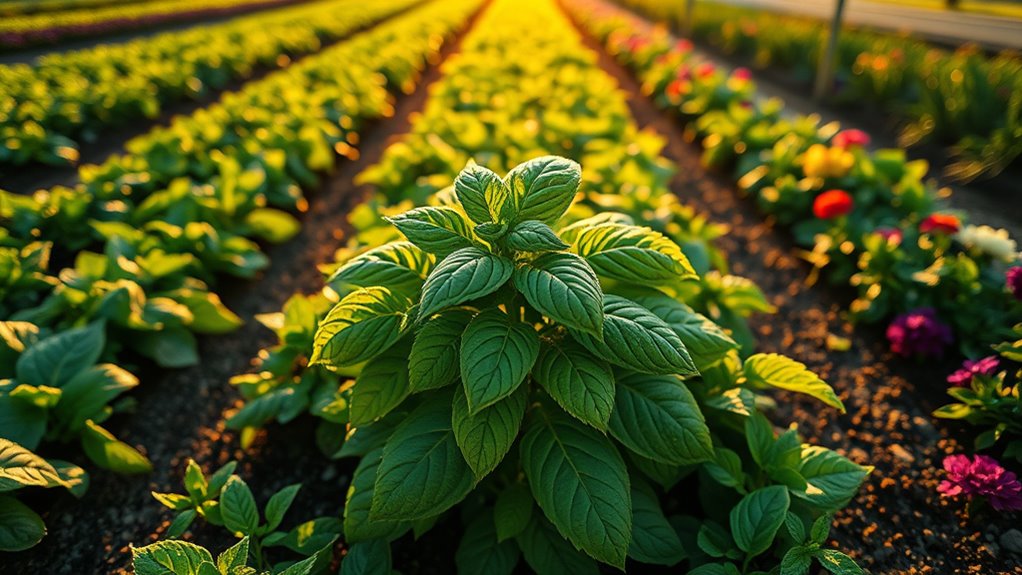What I Learned Growing Tomatoes on My Apartment Balcony
You’ve discovered that growing tomatoes on your apartment balcony starts with picking compact varieties like ‘Tiny Tim’ for easy yields in tight spaces. Set up your area with 6-8 hours of sunlight, wind protection, and well-draining containers to support healthy roots. Keep up daily watering, stake plants for stability, and watch for pests to ensure robust growth. As you master these basics, you’ll uncover even more ways to boost your urban harvest.
Key Takeaways
- Choose compact, determinate tomato varieties like ‘Tiny Tim’ for high yields in small balcony spaces.
- Ensure your balcony receives 6-8 hours of sunlight daily and use well-draining containers for healthy growth.
- Maintain consistent morning watering and prune dead leaves to prevent disease and promote airflow.
- Monitor for pests like aphids early and use natural remedies, such as neem oil, to control infestations.
- Harvest tomatoes when they fully change color and feel firm for optimal flavor and nutrition.
Choosing the Right Tomato Varieties
When you’re selecting tomato varieties for your balcony garden, focus on compact, determinate types that thrive in containers and save space.
In small space gardening, these varieties limit height to 3-4 feet, preventing overcrowding and easing maintenance. Choose hybrids like ‘Tiny Tim’ or ‘Patio Princess’ for their high yield and resistance to common diseases such as blight.
You produce more fruit per square foot by prioritizing sun-loving, early-maturing options that require less staking. For beginners, incorporating easy vegetables can make your balcony garden even more rewarding and low-maintenance.
Scientifically, determinate plants set fruit once, making them practical for urban settings where space and time are limited, ensuring a bountiful harvest.
To further optimize your balcony, pair these tomatoes with other compact vegetables that maximize space in tiny garden areas.
Setting Up Your Balcony Space
Once you’ve selected your tomato varieties, optimize your balcony for success by evaluating sunlight, space, and wind exposure.
Tomatoes need 6-8 hours of direct sunlight daily for optimal photosynthesis; track this with a simple app or by observing shadows, and for balconies with limited natural light, consider using artificial lighting to supplement as needed. Measure your balcony’s dimensions to ensure adequate room for plant spread and height, promoting air circulation to ward off fungal issues.
Assess wind by noting daily patterns—strong gusts increase evaporation and risk stem damage, so use protective barriers like mesh screens.
This strategic setup creates a balanced microclimate, boosting plant health and productivity.
These tips are especially beneficial for urban green thumbs seeking to maximize limited space.
Selecting Containers and Soil
You’ll need to choose container types like pots or fabric grow bags that fit your balcony’s space and support root growth.
Then, select soil options such as a well-draining mix rich in organic matter to nourish your tomatoes effectively. To enhance soil quality for better plant health, consider essential steps that involve tailoring preparation to various environmental conditions.
Make sure your containers meet drainage needs by adding holes or layers to prevent water buildup and root diseases.
Additionally, incorporating soil preparation techniques can further ensure your tomatoes thrive in a balcony setting.
Container Types
Selecting the right containers and soil is essential for healthy tomato growth on your balcony. You’ll need containers that promote drainage, support root systems, and fit your space. Opt for sizes of at least 5 gallons to prevent root-binding. Materials matter: plastic retains moisture, terracotta enhances airflow, and fabric pots offer flexibility. Choose based on your balcony’s conditions for optimal results.
| Container Type | Key Advantages |
|---|---|
| Plastic Pots | Lightweight, moisture-retaining |
| Terracotta Pots | Excellent aeration, stable base |
| Fabric Grow Bags | Superior drainage, portable |
| Wooden Boxes | Natural insulation, aesthetic |
| Self-Watering Pots | Reduces watering needs, efficient |
Soil Options
Just as container choice affects your tomato plants’ roots, soil selection plays a key role in their health.
You’ll need a high-quality potting mix that’s lightweight and rich in organic matter to support root growth and nutrient uptake. Opt for blends formulated for vegetables, which often include peat moss, compost, and perlite for optimal structure.
Check for a pH between 6.0 and 7.0 to prevent nutrient deficiencies—test kits make this easy. Add slow-release fertilizers to maintain steady nutrition, ensuring your plants thrive in limited space.
Always choose sterile mixes to avoid pests and diseases, promoting vigorous growth.
Drainage Needs
Effective drainage is crucial for your tomato plants’ success, as it prevents waterlogged roots that can cause rot and disease.
When selecting containers, choose ones with ample drainage holes to let excess water escape, avoiding pots that trap moisture and invite fungal issues. Opt for materials like terracotta or plastic with perforations; drill holes if needed.
For soil, pick a well-draining mix—such as one with perlite, vermiculite, or coarse sand—to promote aeration and root health. Test it by watering; excess should drain in under 10 minutes.
This keeps roots oxygenated and prevents compaction, ensuring robust growth on your balcony.
Planting Your Tomato Seeds
Once you’ve gathered your tomato seeds, plant them directly into small pots or trays filled with well-draining soil.
Bury each seed about 1/4 inch deep, ensuring even spacing to prevent overcrowding. Use a lightweight mix, like one with perlite or vermiculite, for optimal aeration and root development. Incorporate natural soil preparation to enhance your harvest without relying on fertilizers.
Maintain a soil temperature of 70-80°F using a heat mat if needed, as this boosts germination rates.
Once sprouts appear in 5-10 days, provide bright, indirect light to avoid leggy growth.
Thin seedlings carefully, keeping the strongest ones to foster robust plants for your balcony garden.
Prior to planting, remember that assessing soil health is essential for ensuring your garden setup supports healthy tomato growth.
Daily Watering and Care Routines
Maintaining a consistent watering schedule ensures your tomato plants thrive on your balcony. Water them early in the morning to minimize evaporation and fungal issues.
Aim for soil that’s moist but not saturated—about 1 inch of water per session, checking daily with your finger; if the top inch feels dry, it’s time. Use well-draining pots to prevent root rot, and mulch with organic material to retain moisture. Incorporating expert watering techniques can help avoid common pitfalls in plant hydration.
Prune dead leaves regularly to encourage airflow and fruiting, and apply a balanced fertilizer every two weeks for optimal nutrient uptake. Track plant responses to fine-tune your routine.
During extreme heat, apply essential heat-proof watering tips to keep your tomato plants hydrated and thriving.
Dealing With Common Pests
While pests like aphids and spider mites can invade your balcony tomato plants, you’ll spot them early by checking leaves for signs such as yellowing, webbing, or sticky residue.
Once identified, act quickly to minimize damage using safe, effective methods. Embracing eco-friendly methods ensures a sustainable approach to pest management.
To handle these pests practically:
- Introduce beneficial insects****: Release ladybugs to naturally prey on aphids, reducing populations without chemicals.
- Apply neem oil sprays****: Mix with water and coat leaves; this disrupts pest life cycles scientifically while being plant-safe.
- Prune affected areas: Remove and dispose of infested parts to prevent spread, maintaining plant health effectively.
Additionally, for more options in pest control, consider using effective natural pest sprays made from organic ingredients to keep your garden healthy.
Supporting Plant Growth
After addressing pests, you boost your balcony tomato plants’ growth by implementing key supports like staking and nutrient feeding.
Staking involves inserting sturdy poles next to stems and tying them loosely with soft twine, preventing wind damage and promoting upright growth for better sunlight exposure. This reduces disease risk from soil contact.
For nutrient feeding, apply a balanced fertilizer rich in nitrogen early on, then shift to phosphorus for fruit development; mix it into water every two weeks.
Monitor soil pH around 6.0-6.8 and use compost for organic boosts, ensuring robust yields in limited space.
Monitoring for Ripeness
Once your tomato plants have been supported and fed, you’ll need to monitor for ripeness to harvest at the perfect time. This ensures maximum flavor, nutrition, and yield from your balcony crop.
Regular checks help you catch subtle changes in the fruit’s development.
To monitor effectively, follow these steps:
-
Assess Color Changes: Observe the shift from green to the variety’s full hue, like deep red, indicating increased lycopene levels and maturity.
-
Evaluate Firmness: Gently squeeze the tomato; it should feel firm yet slightly yielding, signaling internal softening without overripeness.
-
Check Size and Gloss: Ensure the fruit has reached expected size with a shiny skin, a practical sign of readiness for picking.
Daily monitoring prevents waste and enhances your harvest.
Troubleshooting Growth Issues
Even though your tomato plants are well-supported and monitored, growth issues can arise that affect their health and yield.
If leaves yellow, check for nutrient deficiencies by testing soil pH and adding organic fertilizer.
Wilting often signals over- or under-watering, so maintain consistent moisture without waterlogging.
Spot pests like aphids early; remove them manually or apply neem oil.
For fungal diseases such as blight, improve air flow and prune infected areas promptly.
Always inspect regularly and act quickly—these steps help you maintain vigorous growth and maximize your balcony harvest.
Expanding Your Urban Garden
Once your tomato plants flourish on your balcony, you can expand your urban garden by incorporating vertical structures or additional containers to maximize space.
This approach boosts yield while conserving limited areas, drawing on principles of urban horticulture. You’ll optimize sunlight and airflow, promoting healthier growth through strategic placement.
-
Install trellises or wall-mounted planters: These support vining plants like beans, increasing vertical space without floor clutter.
-
Add stackable pots or hanging baskets: They allow multi-level planting, enhancing biodiversity and resource efficiency.
-
Incorporate companion planting: Pair tomatoes with herbs like basil to deter pests naturally, improving overall garden resilience.





